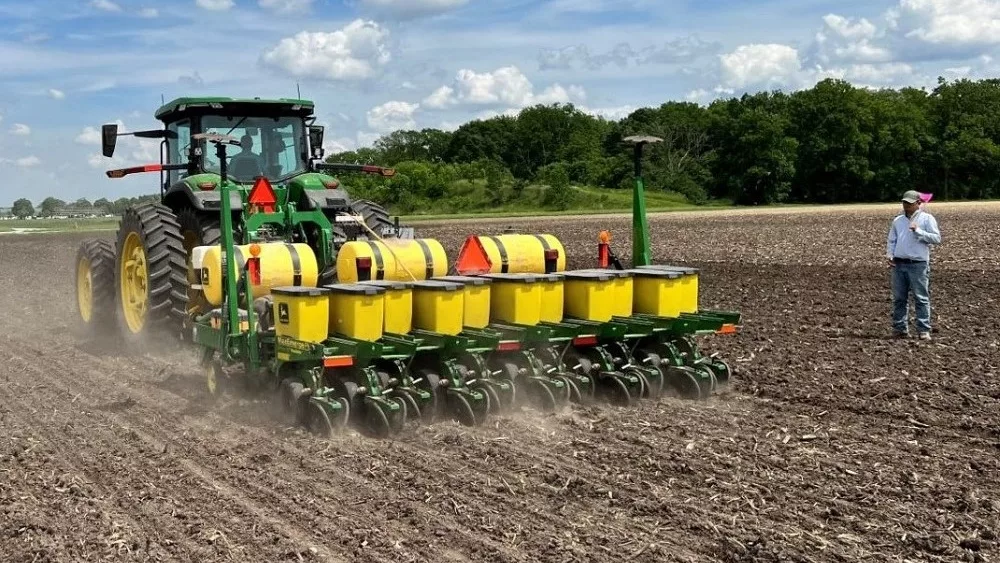
In some areas, the heat and lack of rain are beginning to take a heavy toll on potential yields that are being compromised each day. With little chance of rain predicted in the extended weather forecast – the losses could mount quickly.
One of the first crops to be harvested is wheat. The hot and dry conditions have sped up maturity, and combines have begun to roll in areas of the state. Michigan Farm Bureau Commodity Specialist Theresa Sisung indicates quality appears to be good coming out of the field, and yields are okay.
“Wheat yields have definitely been impacted by hot and dry weather during the end of grain fill,” Sisung said. “The heat has helped crops to catch up in development after a cooler spring. Growing degree days were behind normal across almost all of the state but now the majority of Michigan is slightly above normal.”
According to Sisung, corn and soybeans on heavier soils can draw subsoil moisture but leaf rolling and turning are becoming commonplace. Topsoil moisture has declined dramatically over the past three weeks, with daily evaporation rates reaching a quarter inch or more. That means plants are relying on subsoil moisture to continue growing or just to survive.
Later planted crops with shorter root systems and crops on lighter soils are showing signs of stress. Corn is beginning to show leaf curling. Heavier dews have helped to hold off some of the stress and allowed plants to recover somewhat. Unfortunately, with overnight temps predicted to stay warm over the next several days, there is less chance of a heavy dew.
Farmers in the Lower Peninsula experienced a much better spring for planting and growing conditions this year than in 2019. But once summer officially started June 20, the rains dried up and the mercury headed north of 90 degrees for days.
Rob Rudat is the agronomy manager at County Dairy Inc. in New Era in Oceana County. He oversees 2,000 acres of corn, 750 acres of alfalfa, with the remaining being wheat, rye and oats, all grown on lighter, sandy soil.
“The last 16 days here have been at or above 90 degrees and without any rain,” Rudat said. “Our wheat was hit with a late frost, but luckily we escaped any major issues. And though we expect somewhat normal yields, we’re seeing lower test weights due to that lack of moisture that makes for smaller kernels.
“Because we’re on sandy soils, irrigators are running, putting down three to four-tenths of an inch of water on our corn and alfalfa daily. But even with that, we’re seeing shorter corn stalks and expecting smaller ears. And when it comes to the alfalfa, we’re probably not going to get a fifth cutting this year.”
Sixty miles south of New Era, Jeff Russcher raises corn, soybeans, and hogs on his multi-generational family farm near Zeeland in Allegan County. His crops are grown on what he refers to as medium soil.
“It’s been 10 days since we’ve had any rain worth mentioning, and the heat is sucking the moisture out of the ground at a rapid speed,” Russcher said. “Because of some hard pounding rains we received in May, we got a bit of late start on planting, finishing up on June 8. So, corn pollination is going to be delayed a bit. Hopefully, the rain will come and the heat will subside.”
Based on MSU EnviroWeather models, corn pollination should begin in 10 days or so. And while it has been hot and dry, according to the US Drought Monitor map of July 2, nearly 95% of Michigan is not considered to be in a drought, as of yet. A new map is to be released July 9.
Unfortunately, Michigan State University Extension Agricultural Meteorologist, Jeff Andresen, says most current medium-range forecast guidance calls for a general continuation of the central U.S. ridging upper air pattern that is responsible for the current weather pattern to continue into the second half of July.
“The NOAA Climate Prediction Center revised monthly outlook for July now calls for warmer- and drier-than-normal weather in much of Michigan,” Andresen advised. “Further ahead, the new NOAA long-lead outlook for the July through September period is calling for warmer-than-normal mean temperatures. Similar to the July outlook, it also has backed off on precipitation totals, with mostly equal chances for below-, near-, and above-normal totals.”
That’s not the news farmers want to hear right now says Sisung. “We really need some rain and a break from the hot temperatures prior to corn pollination otherwise the negative impact on yield could be substantial,” she warned.





